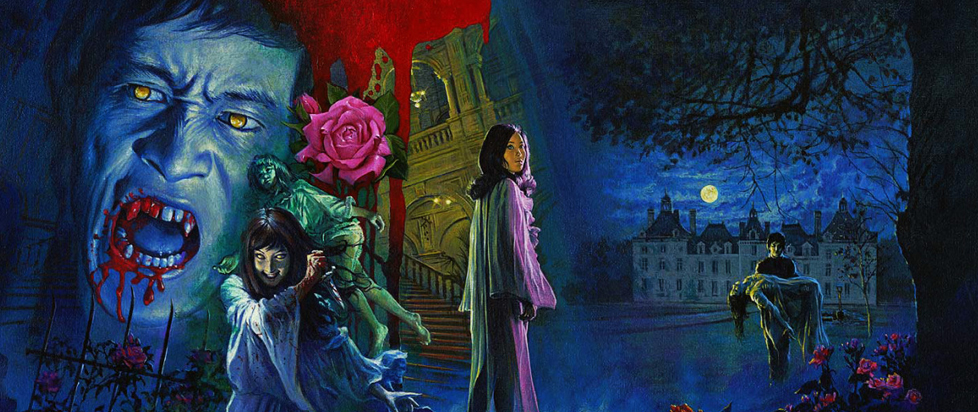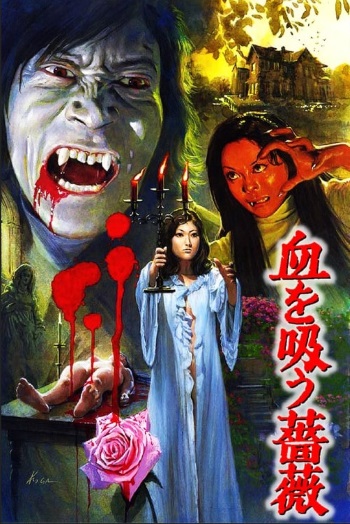This article is a web original.
Marco Cian (Hyogo)
Back in the 70s, Toho Studios got the idea to emulate the style and success of Hammer Horror, which, in hindsight, is rather hilarious when you consider that the 70s were the last dying gasp of Hammer Studios, as it desperately tried to retain its relevence in an age when its name was synonymous with camp. But whatever. No matter how late to the punch Toho was, it knew that Hammer’s Dracula movies were big enough successes to keep dragging Christopher Lee kicking and screaming back for more sequels, and so it decided to produce its own vampire movies.
The result was The Bloodthirsty Trilogy, a trio of thematically-linked films that, to Toho’s credit, were far better Hammer Horror films than what Hammer itself was putting out at the time. Indeed, if these films actually were part of Hammer’s catalog, I think they’d rank among the studio’s best. Sharing the same writer, director, actors, set pieces, and general vibes, it really is clear why these films are regarded as a trilogy, despite them not having any relation to each other plot-wise, and I would recommend people watch them in quick succession to one another, so you can notice all the little details that they share.
The Vampire Doll (The Bloodthirsty Doll) – 1970
Kazuhiko goes to an isolated country town to reunite with his girlfriend, only to learn that she passed away quite tragically while he was away. Initially heartbroken, Kazuhiko is given hope when he sees his girlfriend walking outside at night, and he goes to follow her. But, as you probably guessed, something is terribly wrong at this house, and when Kazuhiko’s sister and her fiancé go looking for Kazuhiko after his own disappearance, they stumble upon dark secrets that the house would prefer to remain hidden.
This feels like a very genre-savvy vampire flick. While it starts out very similarly to Horror of Dracula, it ends up going down its own, wild path. Typically I’m annoyed by works that try to subvert audience expectations for the sheer sake of seeming clever, but in this case, I do think the plot is clever enough (and, more importantly, good enough) for this subversion to make sense. The fact that vampires are foreign to Japan helps the protagonists remain ignorant until the film’s climax while not frustrating the viewer. And, when the climactic twist arrives, you realize that the protagonists were a lot less ignorant than you may have thought.
Lake of Dracula (The Bloodthirsty Eyes) – 1971
18 years ago, Akiko had an encounter with a vampire, but repressed the memory and is now convinced it was merely a dream. Living in a lakehouse, Akiko keeps painting an eerie lake, being subconsciously drawn to the image. And when a coffin arrives at the lake, carrying an all-too-familiar passenger, Akiko must confront this monster and the memories she suppressed of it all those years ago.
This was the first Bloodthirsty movie I ever learned about, first hearing about it in college. And while at that time there was no real way of watching it, the image of Mori Kishida as the vampire remains seared into my mind. I can easily see why they got him back for the next film and gave him an even meatier role. It’s also got a pretty nice take on memory repression, where it’s not so much a fancy psychological phenomenon as it is the child doesn’t want to be punished, so she tells everyone it was just a dream, and then after years of telling people that for so long, she becomes convinced herself. Lake also has a unique, albeit somewhat questionable, idea on how vampirism is passed down. Like Bram Stoker, the filmmakers recognized the parallels between vampirism and racialist ideas of incorporation and infiltration, but unlike Stoker they play these ideas straight instead of subtly criticizing them. It didn’t exactly sit well with me, but I can at least appreciate it for shaking up the vampire formula.
Evil of Dracula (The Bloodthirsty Rose) – 1974
Traveling from Tokyo to the Nagano countryside, Professor Shiraki takes up a post at an isolated, all-girls’ school. His arrival coincides with a terrible tragedy, as the wife of the school’s principal is killed in a drunk driving accident, and the principal himself announces his retirement due to illness. But there are even more mysterious and tragic incidents to come, as a ghostly woman in a blue nightgown, who looks just like a student that recently disappeared, begins stalking the grounds. How are these tragedies connected? And can Shiraki save his students before dark forces consume them?
This is basically Hammer’s Lust for a Vampire, but better in just about every way (except for the unintentional comedy value, because nothing is funnier than 70s Hammer’s attempts to be taken seriously). The origin story of the vampire (a Portuguese priest who trampled on the fumi-e and subsequently made a pact with Satan), is not simply a unique spin on the way vampires work in the Karnstein trilogy, but also avoids some of the more unfortunate implications of Lake of Dracula‘s rules on vampirism by pointing out how even if vampirism is a foreign monster, it is a monster created by the native Japanese. It also has a truly spooky evil plan on the part of the vampires, involving a method of passing down vampirism that I’d never seen before. And while I’m not a fan of the romance between the middle-aged teacher and the 16-year-old student, things are thankfully kept chaste enough that you could read the relationship as platonic.
All in all, I would say that The Bloodthirsty Trilogy manages to blend the mood and atmosphere of 50s Hammer with the special effects and budget of 70s Hammer, and the end result is a truly spooky and entertaining experience. I thoroughly recommend them all!
Marco Cian is a second-year ALT in Hyogo Prefecture, who has loved vampires ever since he first watched Horror of Dracula late one night in college. If you want to read more of his reviews and recommendations, you can do so at his website here.



![CONNECT ART ISSUE 2024 SUBMISSIONS [CLOSED]](https://connect.ajet.net/wp-content/uploads/2024/04/ARTISSUE-INSTA-600x500.png)








